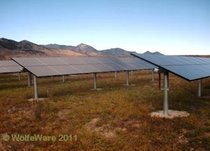Pioneering renewable energy for business and communities & more
Pioneering renewable energy for business and communities & more
About Solar Parks
Solar parks (or solar farms, solar ranches) are large scale, usually ground-mounted, solar generating stations designed to feed power into the utility grid
WolfeWare website:
@philip_wolfe
© WolfeWare Limited 2014-18
Though the first such installations date back to the 1980’s the majority of utility-scale generation has been installed in this century as described in this outline history.
How do they work?
Solar generating stations have three main active subsystems:
The arrays of solar modules, which convert light to DC electricity
Inverters to convert the DC power to AC
Transformers to increase the output to grid voltage
The solar modules include a number of interconnected solar cells, which are semi-conductor devices processed to produce DC current when irradiated with light. The output is proportional to the area and the amount of incident light. While the best output is therefore in direct sunshine, some power is produced even under overcast skies. The solar modules are mounted on structures to angle them towards the sun. Fixed structures are usually used in the UK, though tracking systems which follow the sun across the sky may be justified in less temperate climates.
In addition to the primary equipment described above the systems will be fitted with monitoring equipment to keep a constant check on system performance; security systems and other infrastructure.
A typical solar park in Southern England of, say, 10MWp would require about 24 hectares; produce c. 10,000 MWh/year; saving about 4,500 tonnes of CO2. In mid 2013, it would cost just over £10m and earn about £30m in its first 20 years of operation.
How are projects implemented?
Projects are typically initiated by a so-called project developer, who will identify a suitable site, agree terms with the land-owner, and obtain the necessary planning and grid connection consents. Some developers retain ownership of the project but many sell the completed plant (or the project under development) to an independent power producer or financial fund to finance and operate the project and receive the income (and any benefits or incentives) from the power it produces.
A specialist contractor is usually appointed for the Engineering, Procurement and Construction of the plant. They will complete the final design, procure the modules, mounting structures, inverters, transformers and other equipment and to oversee the installation of the plant. An operation and maintenance contractor (often the original EPC contractor) is appointed to ensure the long-term effective operation of the system.
In most cases a proportion of the cost is funded by external finance providers, who will carry out due diligence on all aspects of the design and planning of the project.
How WolfeWare can help
Because of our knowledge and experience in the sector, we can provide advisory support and due diligence services to existing and prospective plant owners, project developers, financiers and contractors.
Some examples of the advisory support we can offer are shown here. If you want to explore the possibilities further, please email us outlining your requirements with contact details where we can call or email you.
For more information
There's no better way to find out all about utility-scale solar parks than to read Philip Wolfe's book!
This Wikipedia page has been developed with input from WolfeWare collaborators, and gives a good overview of utility-scale PV applications.
